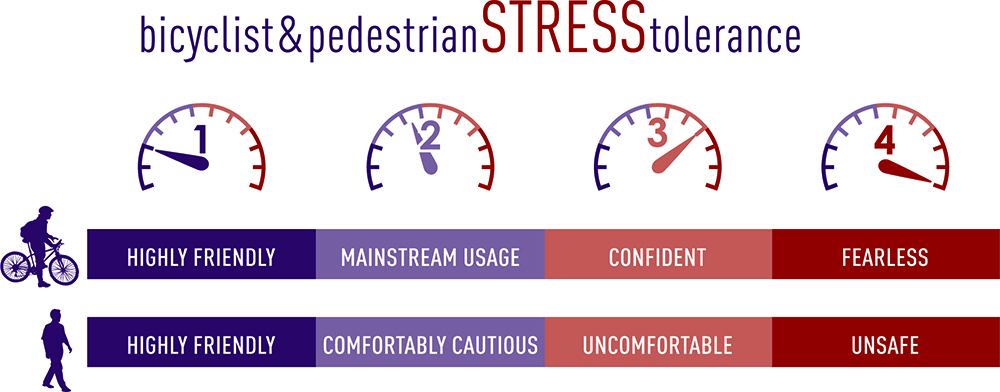
As active transportation for commuting, recreation, and utilitarian trips continues to grow in our nation’s cities, transportation professionals, governmental entities, non-profits, developers and private sector entities (such as companies with large campuses) are seeking information that will help evaluate how urban areas can become friendlier for people walking and bicycling. Research on people who bicycle or are interested in bicycling reinforces that perceptions of comfort and safety influence a person’s likelihood to bicycle. For the transportation practitioner, it is therefore critical to make sure that the design of low stress bikeways such as protected lanes (also known as “cycle tracks” or “separated bikeways”) and bicycle boulevards, provide a consistent low-stress experience for bicyclists of all abilities. For people walking, comfort and perception of safety are also paramount, both for those who walk today and those who might walk more in the future.
As planning and engineering professionals are faced with these increasingly complex transportation issues, the need for effective, low-data intensity, and customizable analysis tools to convey trade-offs and design alternatives to stakeholders is ever more apparent. To address this need, our Bicycle & Pedestrian Discipline Group created a quick response tool through the Fehr & Peers ASAP initiative. The tool, StreetScore+, is an easy-to-use tool that calculates comfort for both people bicycling and people walking.
Quickly and effectively compare designs and convey project benefits to stakeholders.
For both people bicycling and people walking, StreetScore+ adopts the “weakest link” principle and one to four scoring system of the Mekuria, Furth, and Nixon (2012) Level of Traffic Stress methodology. This means a full segment receives the score of its lowest-scored portion. For example, a cross-town ride or walk could have large portions of StreetScore+ 1 and StreetScore+ 2, but just one section of StreetScore+ 3 would present a barrier. Only bicyclists that could tolerate StreetScore+ 3 would ride the entire route. So, StreetScore+ 3 becomes the score for that route.
For people bicycling, the tool calculates both the Mekuria, Furth and Nixon (2012) Level of Traffic Stress methodology, and specifically for protected lanes and bicycle boulevards, uses a parallel scoring methodology, to provide a refined comfort metric consistent with the NACTO Urban Bikeway Guide, 2nd Edition. Within the LTS methodology, separated bikeways receive an LTS score of 1; however, as these facilities have rolled out across the nation, separated bikeways can vary greatly in terms of level of protection afforded to bicyclists and how protection from autos is treated at intersections. As a result, StreetScore+ can be used to understand their real level of comfort, which can be critical in the planning and conceptual design phases as well as in evaluating existing facilities.
For people walking, StreetScore+ has a parallel structure with a scale of one to four. The NACTO Urban Streets Design Guide (USDG) and engineering judgment provide the basis for pedestrian StreetScore+. The USDG provides critical, recommended, and optional parameters for the pedestrian environment consistent with best practices and documents supporting guidance and literature. Additional considerations of comfort are informed by practitioner and best practice experience. In the future, metrics for people riding transit and people driving can be integrated into this methodology to evaluate roadway comfort all users.
StreetScore+ 1
For bicyclists, most children can tolerate StreetScore+ 1 and feel safe while bicycling. For pedestrians, StreetScore+ 1 indicates a highly pedestrian-friendly and easily navigable environment for people of all ages and abilities.
StreetScore+ 2
For bicyclists, this is the highest level of stress that the mainstream adult population will tolerate while still feeling safe. For pedestrians, walking is generally comfortable, but parents may not feel comfortable letting their children walk alone.
StreetScore+ 3
Bicyclists who are considered “enthused and confident” but still prefer having their own dedicated space for riding will tolerate this level of stress and feel safe while bicycling. For pedestrians, walking is uncomfortable but possible, with some barriers that make walking uninviting or uncomfortable.
StreetScore+ 4
For bicyclists, this is tolerated only by those characterized as “strong and fearless”, which comprises a small percentage of the population. These roadways have high speed limits, multiple travel lanes, limited or non-existent bike lanes and signage, and large distances to cross at intersections. For pedestrians, walking is very uncomfortable or even impossible. Streets have limited or no accommodation and may be unsafe for people walking.
Learn more by contacting one of our industry experts.
Quick Links
© 2017 – 2024 Fehr & Peers. All rights reserved.


